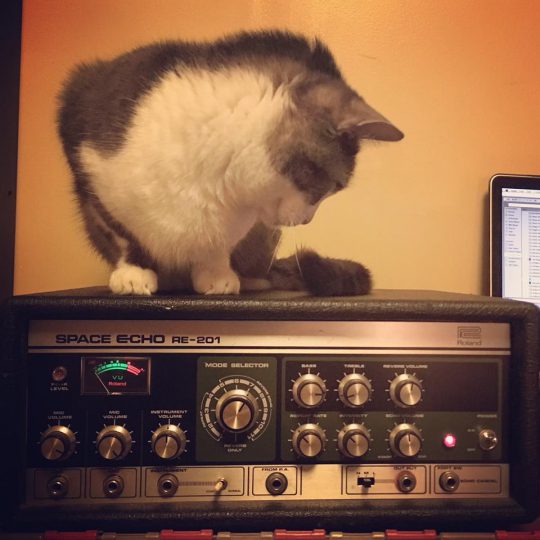
Biggie Smalls contemplates a vintage Roland Space Echo RE-201. From Brandon Fitzsimons via our Facebook page.
“What’s making that noise in there??”
The RE-201 continues to be prized by musicians for its sound. It is actually a true tape-echo machine (plus a spring reverb).
[Ikutaro] Kakehashi’s breakthrough development came in 1974 with the RE-101 and RE-201 Space Echo units, which used the standard 1/4″ tape of the open-reel variety, but made as one, continuous loop. It uses no reels of any kind; the tape is transported via a capstan drive. The tape loop is contained in a loose, constantly moving jumble in the tape chamber (also known as the tape tank) under a plastic panel which protects the tape and keeps it from getting tangled. The design resulted in lower levels of noise, wow, and flutter, and cut down on tape wear.[1] Replacement tapes were sold as well, named RT-1L.[2]
https://en.wikipedia.org/wiki/Roland_RE-201
There are several control dials on the device that alter such aspects as tape speed, repeat pattern (an 11-position rotary switch), one instrument and two microphone inputs, a single analog backlit VU meter for all three inputs, wet/dry mix for both echo and reverb, and intensity (number of repeats), that can be adjusted to a user’s liking; and bass/treble controls to EQ the sound of the repeats (not the dry signal), as well as dry and effected “Echo” output jacks with a switch for output setting (-10, -20, -35db levels.)
It is interesting to read this as I have been working extensively of late with the Magneto tape-echo simulator module from Strymon. You can see our review of the echo mode in this recent video.

Happy Mardi Gras!! We always love coming here to see the beautiful kitty. The video you shared was very cool and we always love to educate ourselves more. Thanks for the share.